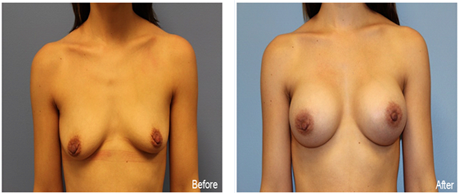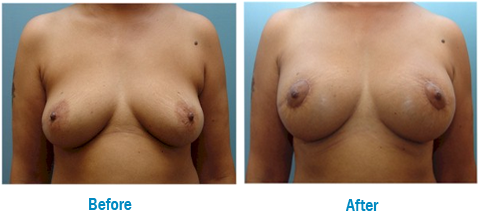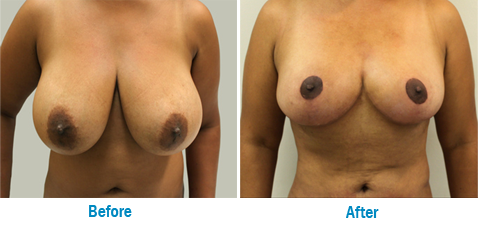BREAST AUGMENTATION

Breast augmentation is one of the most frequently performed cosmetic procedures. Placement of breast implants has tremendous benefits to self esteem and confidence, ease of wearing clothing and gender identity. The satisfaction rate from breast augmentation surgery is extremely high.
Appropriate breast augmentation mammoplasty are those women with breast or rib cage asymmetry,volume loss with pregnancy,mild sag or ptosis,small breastsize in proportion to the rest of the body or to correct breast volume loss from surgical means or trauma.
There are two types of implants currently availablethese are saline filled implants with a silicone elastomer shell and cohesive silicone gel filled implants, also with a silicone elastomer shell. The patient must be at least 22 years of age to have a silicone gel implant placed. The type of implant right for you will depend on your individual goals and circumstances, your exam and discussion with your plastic surgeon. It may be that both are equally good options for you, in which case with the help of your plastic surgeon, the style that best matches your goals will be selected. Some of the differences of saline and silicone implants are listed below. Saline is less expensive, firmer, and has more ripple potential. It also can be put into a smaller incision no matter the size of the implant and is adjustable in volume.
Silicone gel is more expensive, tends to be softer and show ripples less, however, it needs a bigger incision the bigger the implant gets. It is also the most natural feeling implant because the silicone gel is thicker and more the consistency of body tissues. There are three incision options for placement of a breast implant: Transaxillary – from the under arm area, in which an endoscope is used to assist in creation of the pocket, Inframammary—in the breast crease, and Periareolar—from the nipple area. You may be a good candidate for only one of these approaches, or all three. There are two pocket options for the implant itself: under the pectoralis major muscle (submuscular, partial submuscular or biplanar), and under the breast gland itself (subglandular). The surgeons at Sculptura Aesthetic Surgery Centre have extensive experience in all of the incisions and both pocket placement options. They will assist you in selection of the best approach suited for your breast augmentation needs.
BREAST LIFT

Over the years, pregnancy, nursing , and the force of gravity take their toll on a woman's breasts. As the skin loses its elasticity, the breasts often lose their shape and firmness and begin to sag. Breast lift, or mastopexy, is a surgical procedure to raise and reshape sagging breasts--at least for a time. Mastopexy can also reduce the size of the areola, the darker skin surrounding the nipple. If your breasts are small or have lost volume--for example, after pregnancy--breast implants inserted in conjunction with mastopexy can increase both their firmness and their size.
THE BEST CANDIDATES
The best candidates for breast lift surgery are healthy, emotionally stable women who are realistic about what the surgery can accomplish. The best results are usually achieved in women with sagging breasts. Breasts of any size can be lifted.
Many women seek mastopexy because pregnancy and nursing have left them with stretched skin and less volume in their breasts. However, if you're planning to have more children, it may be a good idea to postpone your breast lift. While there are no special risks that affect future pregnancies (for example, mastopexy usually doesn't interfere with breast-feeding), pregnancy is likely to stretch your breasts again and offset the results of the breast lift procedure.
BREAST REDUCTION

BREAST REDUCTION (FEMALE) SURGERY
Women with very large, pendulous breasts may experience a variety of medical problems caused by the excessive weight. These include back and neck pain, skin irritation, skeletal deformities and breathing problems. Bra straps may leave indentations in their shoulders. And unusually large breasts can make a woman or teenage girl feel extremely self-conscious.
WHAT IS IT?
Breast reduction, technically known as reduction mammaplasty, is designed for such women. The procedure removes fat, glandular tissue, and skin from the breasts, making them smaller, lighter, and firmer. It can also reduce the size of the areola, the darker skin surrounding the nipple. The goal is to give the woman smaller, better-shaped breasts in proportion with the rest of her body.
THE BEST CANDIDATES
Breast reduction is usually performed for physical relief as well as cosmetic improvement. Most women who have the surgery are troubled by very large, sagging breasts that restrict their activities and cause them physical discomfort. In most cases, breast reduction isn't performed until a woman's breasts are fully developed. However, it can be done earlier if large breasts are causing serious physical discomfort. The best candidates are those who are mature enough to fully understand the procedure and have realistic expectations about the results. Breast reduction is not recommended for women who intend to breast-feed.


